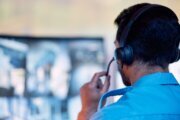As a new student at the University of Texas–Austin in the fall of 2008, I was excited to learn and enthusiastic about the world of possibility before me. Little did I know that one of the toughest lessons of my life — and the one I least expected — was in store for me at UT. During my first semester, I contracted meningococcal disease, sometimes referred to as meningitis, a rare but deadly disease I knew nothing about. Meningitis can be fatal or cause disability, sometimes within 24 hours of symptoms; 1 in 10 of those who contract it will die, and 1 in 5 will suffer lifelong disabilities. I didn’t know that I was at increased risk as a college student living in a dormitory because of the way the disease is transmitted: coughing, sneezing, sharing utensils, kissing and living in close proximity to others. Perhaps most importantly, I didn’t know that I could help prevent it. I learned the hard lesson of meningitis: What you don’t know can hurt you.
Shortly after my flu-like symptoms appeared, my condition rapidly deteriorated. In less than 24 hours, I was in the hospital fighting for my life. Doctors had to amputate my legs and fingers, and I spent several months in the hospital.
The recovery process was challenging. In addition to the amputations of my legs and fingers, I had several surgeries and endured tremendous pain, weight loss and hair loss. I almost didn’t recognize myself, and my spirits were at an all-time low. Thanks to my family and friends and an amazing support network, I went from wondering “why me?” to wondering “why anyone?” — and have made it my life’s work to educate young people and their parents to try to help them from having to learn the lesson of meningitis the hard way.
[See: How to Disinfect Germ Hotspots.]
As I progressed through rehabilitation and learned to walk using prosthetics, I began to tell my story. First I spoke at local church and community events, and then to other organizations in Texas and the rest of the United States. I worked to help pass a law in Texas requiring all in-state college students get the meningitis vaccine available at the time. (Today, there are two vaccines available to help prevent meningitis.)
The hard lesson of meningitis has transformed me in many ways. I am proud to say that I went from being a commuter cyclist — before meningitis I biked to my classes and around campus — to a competitive cyclist. I learned to bike again after meningitis and went on to win a gold medal at the 2011 U.S. Paralympic Games.
[See: 10 Concerns Parents Have About Their Kids’ Health.]
While I still love cycling and the freedom it brings, these days I am more focused on creating awareness about vaccines for meningitis. To help raise awareness about meningitis, I founded a non-profit organization, the J.A.M.I.E. Group. As my advocacy grew, I was invited to do my first of several photo shoots with renowned photographer and vaccine advocate Anne Geddes. This year, I became a GSK spokesperson to help spread the word about meningitis.
I am now a paralympic gold medal winner, founder of a non-profit, spokesperson for meningitis awareness, advocate for getting laws passed and more. My hard lesson has put me in a position to help others avoid the dangers of meningitis. My message is simple:
1. Get educated before it’s too late. Anyone can get meningitis, but teens and young adults are at increased risk. There are now two vaccines that together help protect against five vaccine-preventable groups of meningitis (A, C, Y, W and B). Up to 30 percent of cases are caused by group B meningitis.
2. Ask your doctor about the two vaccines available to protect against meningitis. You need two vaccines to help protect against five vaccine-preventable groups of meningitis. The first vaccine helps protect against four groups of meningitis (A, C, Y and W) and is recommended for young teens. A second vaccine helps protect against meningitis B. Speak to your doctor about meningitis and whether these vaccines are right for you.
[See: 13 Tips for Getting Kids Health-Ready for Back to School.]
3. Make meningitis a lesson no one has to learn the hard way. We have the power to help prevent meningitis, but we have to build awareness of the disease, especially among young adults and their parents. So take time to get educated and talk to your family and friends and anyone you know who might be at risk. Know the risk factors, signs and symptoms and the importance of vaccination. Urge others to talk to their physicians about vaccinations. My dream is to help others from experiencing meningitis. It can be done, with your help. Won’t you join me?
Jamie Schanbaum is a meningitis survivor, patient advocate and GSK spokesperson.
More from U.S. News
11 Ways Healthy Community Design is Working
13 Tips for Getting Kids Health-Ready for Back to School
How to Disinfect Germ Hotspots
I Lost My Legs and Fingers to Meningitis, and This Is What I Learned originally appeared on usnews.com







